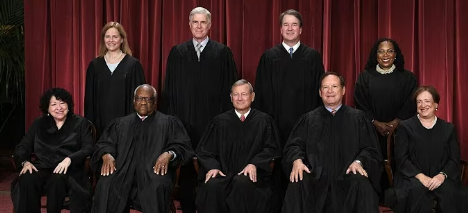In a landmark 6-3 decision, the U.S. Supreme Court has officially shut the door on a controversial legal tactic that has plagued multiple administrations: nationwide injunctions. Friday’s ruling sharply curtails the ability of federal district judges to issue blanket orders that block laws or executive actions across all 50 states—effectively handing a major win to the Trump administration and restoring long-ignored limits on judicial power.
This wasn’t just a technical tweak in court procedure. This was a full-on rebuke of judicial overreach, a reset of constitutional balance, and the beginning of the end for activist lawfare waged from coast to coast.
What the Case Was About (And What It Wasn’t)
Let’s set the record straight. This wasn’t a decision about birthright citizenship itself. The underlying case stemmed from President Trump’s 2025 executive order addressing birthright citizenship for children of illegal immigrants—an order that predictably ran into legal barricades from lower courts.
But rather than evaluating the policy, the Supreme Court focused on a more foundational issue: Can a single district court judge issue an order that halts an entire federal policy nationwide, for everyone—not just the plaintiffs involved?
The Court’s answer: Absolutely not.
Chief Justice Roberts and the majority held that district courts are limited to granting relief only to the parties before them. That means no more sweeping nationwide blocks from one court in California, New York, or anywhere else. If activists want to stop a federal policy for the whole country, they’ll need to win it the hard way—through legislation or broader class actions.
A Win for the Constitution—and Common Sense
The ruling marks a clear return to originalist principles. The Court majority looked back at the Judiciary Act and the founding era and found no support for the modern practice of nationwide injunctions. It was, in their words, a “modern invention”—one that never should’ve existed in the first place.
As constitutional law attorney David Cole explained in media interviews, the justices were essentially saying: This isn’t how our system was designed to work. Courts settle disputes between parties. They don’t govern the country.
The majority opinion underscored that point: “We cannot permit the Constitution to be redefined through unauthorized innovation,” the ruling read. “Doing so would erase the boundary between adjudication and legislation.”
Lawfare Just Took a Major Hit
Over the past several years, particularly during the Trump presidency, we’ve seen a flood of coordinated legal attacks—often referred to as “lawfare.” This is where political opponents run to friendly judges in ideologically aligned districts to block executive orders or new laws before they can even take effect. And it worked—repeatedly.
As the Court noted, by the end of the Biden administration, you couldn’t pass a law without someone running to a courtroom to block it. Trump’s executive orders were stopped in their tracks by judges issuing nationwide injunctions—often at the request of a handful of progressive legal groups.
This ruling doesn’t just put the brakes on that—it throws the whole strategy into the scrap heap.
No more judge-shopping for a magic gavel to stop the federal government. No more one-judge vetoes of national policy. The days of activist bench legislation are over.
The Dissent: Sotomayor and the Progressive Playbook
As expected, Justice Sonia Sotomayor dissented, joined by Justices Kagan and Jackson. Their argument? That society is more complex now and courts need flexibility to handle national problems. In other words, forget the Constitution—we need to modernize.
Her dissent criticized the majority for failing to adapt to today’s legal landscape, warning that limiting nationwide injunctions could create inconsistent enforcement across states and complicate future legal challenges.
But that’s not how justice is supposed to work. The majority reminded us that the Constitution doesn’t change based on convenience or complexity. Laws must be interpreted based on their original meaning—not reinvented for modern political expedience.
This Isn’t Just About Trump—It’s About the Future
While this decision comes during Trump’s second term and is being celebrated by conservatives, its impact stretches far beyond any single administration. This ruling cuts both ways.
As Cole pointed out, “This decision will also limit Republican-appointed judges from issuing broad blocks against future Democrat policies.”
And that’s exactly the point. This isn’t a partisan win. It’s a constitutional correction. The Court isn’t picking sides—it’s restoring order. It’s saying: if you want to change the law, go to Congress, not your favorite district judge.
What Happens Next?
Going forward, legal challenges to federal policy will have to follow the traditional path. If you want to stop a law from being enforced nationwide, you’ll need:
-
A broader class-action suit
-
A legitimate pathway through the appellate courts
-
A final ruling from the Supreme Court itself
That means more effort, more process, and—yes—more accountability. But it also means fewer end-runs around democracy.
Even the Biden-era mifepristone (abortion pill) litigation, often centralized in a single Texas courtroom, may now fall under scrutiny. If one judge can no longer dictate national abortion policy, then future challenges will require broader coalitions and stronger legal footing.
The Big Picture: This Is How You Drain the Judicial Swamp
This Supreme Court ruling on nationwide injunctions might not have the same media sizzle as other headline-grabbing decisions, but make no mistake—it’s one of the most important rulings of the term.
Why? Because it restores one of the most basic principles of our government: Separation of powers.
It reminds the judiciary to stay in its lane, keeps activist lawyers from hijacking national policy through loopholes, and tells both parties to fight their battles the way the Founders intended—through the democratic process.
This is what a healthy judiciary looks like. This is what a constitutional reset feels like.
And once again, it proves: elections matter.
WE’D LOVE TO HEAR YOUR THOUGHTS! PLEASE COMMENT BELOW.
JIMMY
Find more articles like this at steadfastandloyal.com
h/t: Steadfast and Loyal

